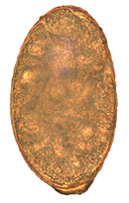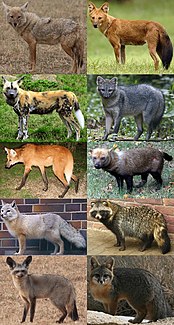
Q fever is a disease caused by infection with Coxiella burnetii, a bacterium that affects humans and other animals. This organism is uncommon, but may be found in cattle, sheep, goats, and other domestic mammals, including cats and dogs. The infection results from inhalation of a spore-like small-cell variant, and from contact with the milk, urine, feces, vaginal mucus, or semen of infected animals. Rarely, the disease is tick-borne. The incubation period is 9–40 days. Humans are vulnerable to Q fever, and infection can result from even a few organisms. The bacterium is an obligate intracellular pathogenic parasite.
Ehrlichiosis (; also known as canine rickettsiosis, canine hemorrhagic fever, canine typhus, tracker dog disease, and tropical canine pancytopenia is a tick-borne disease of dogs usually caused by the organism Ehrlichia canis. Ehrlichia canis is the pathogen of animals. Humans can become infected by E. canis and other species after tick exposure. German Shepherd Dogs are thought to be susceptible to a particularly severe form of the disease, other breeds generally have milder clinical signs. Cats can also be infected.

Rickettsia rickettsii is a gram-negative, intracellular, coccobacillus bacterium that is around 0.8 to 2.0 micrometers long. R. rickettsi is the causative agent of Rocky Mountain spotted fever. R. rickettsii is one of the most pathogenic Rickettsia strains. It affects a large majority of the Western Hemisphere and small portions of the Eastern Hemisphere.

Oroya fever or Carrion's disease is an infectious disease produced by Bartonella bacilliformis infection.
Coccidiosis is a parasitic disease of the intestinal tract of animals caused by coccidian protozoa. The disease spreads from one animal to another by contact with infected feces or ingestion of infected tissue. Diarrhea, which may become bloody in severe cases, is the primary symptom. Most animals infected with coccidia are asymptomatic, but young or immunocompromised animals may suffer severe symptoms and death.
Rat-bite fever is an acute, febrile human illness caused by bacteria transmitted by rodents, in most cases, which is passed from rodent to human by the rodent's urine or mucous secretions. Not to be confused with Rat fever which is usually alternative name for Leptospirosis. Alternative names for rat-bite fever include streptobacillary fever, streptobacillosis, spirillary fever, bogger, and epidemic arthritic erythema. It is a rare disease spread by infected rodents and can be caused by two specific types of bacteria. Most cases occur in Japan, but specific strains of the disease are present in the United States, Europe, Australia, and Africa. Some cases are diagnosed after patients were exposed to the urine or bodily secretions of an infected animal. These secretions can come from the mouth, nose, or eyes of the rodent. The majority of cases are due to the animal's bite. It can also be transmitted through food or water contaminated with rat feces or urine. Other animals can be infected with this disease, including weasels, gerbils, and squirrels. Household pets such as dogs or cats exposed to these animals can also carry the disease and infect humans. If a person is bitten by a rodent, it is important to quickly wash and cleanse the wound area thoroughly with antiseptic solution to reduce the risk of infection.

Strangles is a contagious upper respiratory tract infection of horses and other equines caused by a Gram-positive bacterium, Streptococcus equi. As a result, the lymph nodes swell, compressing the pharynx, larynx, and trachea, and can cause airway obstruction leading to death, hence the name strangles. Strangles is enzootic in domesticated horses worldwide. The contagious nature of the infection has at times led to limitations on sporting events.

Lymphoma (lymposarcoma) in animals is a type of cancer defined by a proliferation of malignant lymphocytes within solid organs such as the lymph nodes, bone marrow, liver and spleen. The disease also may occur in the eye, skin, and gastrointestinal tract.
Canid alphaherpesvirus 1, formerly Canine herpesvirus (CHV), is a virus of the family Herpesviridae which most importantly causes a fatal hemorrhagic disease in puppies less than two to three weeks old. It is known to exist in the United States, Canada, Australia, Japan, England and Germany. CHV was first recognized in the mid-1960s from a fatal disease in puppies.
Hemorrhagic gastroenteritis (HGE) is a disease of dogs characterized by sudden vomiting and bloody diarrhea. The symptoms are usually severe, and HGE can be fatal if not treated. HGE is most common in young adult dogs of any breed, but especially small dogs such as the Toy Poodle and Miniature Schnauzer. It is not contagious.

Anaplasma phagocytophilum is a Gram-negative bacterium that is unusual in its tropism to neutrophils. It causes anaplasmosis in sheep and cattle, also known as tick-borne fever and pasture fever, and also causes the zoonotic disease human granulocytic anaplasmosis.
Potomac Horse Fever (PHF) is a potentially-fatal febrile illness affecting horses caused by the intracellular bacterium Neorickettsia risticii. PHF is also known as Shasta River Crud and Equine Monocytic Ehrlichiosis. It was first described in areas surrounding the Potomac River northwest of Washington, D.C., in the 1980s, but cases have been described in many other parts of the United States, such as Minnesota, California, and Pennsylvania. Currently, it is found in more than 40 U.S. states and Canada.

Bubonic plague is one of three types of plague caused by bacterium Yersinia pestis. One to seven days after exposure to the bacteria, flu-like symptoms develop. These symptoms include fever, headaches, and vomiting. Swollen and painful lymph nodes occur in the area closest to where the bacteria entered the skin. Occasionally, the swollen lymph nodes may break open.
Tropical theileriosis or Mediterranean theileriosis is a theileriosis of cattle from the Mediterranean and Middle East area, from Morocco to Western parts of India and China.
Actinobacillosis is a zoonotic disease caused by Actinobacillus.
Lymphatic disease is a class of disorders which directly affect the components of the lymphatic system.

Nanophyetus salmincola is a food-borne intestinal trematode parasite prevalent on the Pacific Northwest coast. The species may be the most common trematode endemic to the United States.
Amphistomiasis is a parasitic disease of livestock animals, more commonly of cattle and sheep, and humans caused by immature helminthic flatworms belonging to the order Echinostomida. The term amphistomiasis is used for broader connotation implying the disease inflicted by members of Echinostomida including the family Paramphistomidae/Gastrodiscidae ; whereas paramphistomiasis is restricted to that of the members of the family Paramphistomatidae only. G. discoides and Watsonius watsoni are responsible for the disease in humans, while most paramphistomes are responsible in livestock animals, and some wild mammals. In livestock industry the disease causes heavy economic backlashes due to poor production of milk, meat and wool.

Unicentric Castleman disease is a subtype of Castleman disease, a group of lymphoproliferative disorders characterized by lymph node enlargement, characteristic features on microscopic analysis of enlarged lymph node tissue, and a range of symptoms and clinical findings



















